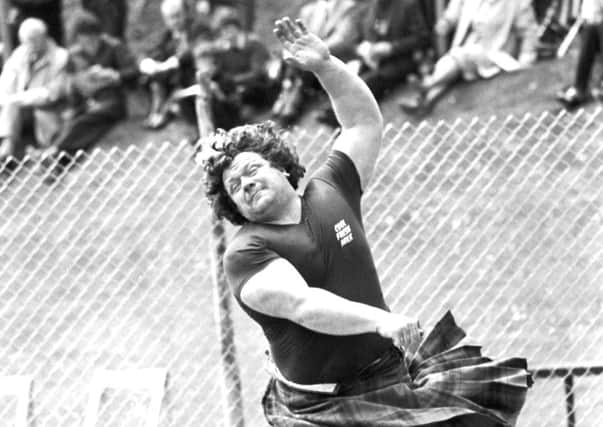Obituary: Hamish Davidson, Highland Games heavyweight athlete


Hamish Davidson was an outstanding and colourful Scottish Highland Games heavyweight athlete from the 1970s into the 1990s who had previously excelled as an international shot putter.
He won his first Scottish shot putt title in 1973 while still a junior and repeated that success in 1975 and 1978, on the latter occasion setting a championship record that would last for 18 years.
Advertisement
Hide AdAdvertisement
Hide AdAn eight times Scottish international who also won three consecutive national amateur Games heavyweight titles between 1975 and ’77, he turned professional in 1978 to concentrate on Highland Games. His powerfully squat figure, with trademark long white hair and droopy moustache, soon became a familiar sight on games fields up and down the country as he excited crowds with record-breaking feats of strength in the traditional events, including the weight for distance, Scots hammer, caber and shot.
In 1979 he won the coveted Scottish professional heavyweight championship at Crieff, defeating rivals of the calibre of Grant Anderson and the legendary Bill Anderson, Scotland’s greatest heavy athlete. Further success followed in winning the heavyweight crowns at the prestigious Braemar and Aboyne Games, as well as the Glenfiddich Championship several times for the highest aggregate points total over the season. He also set a world best in throwing the 28lb weight.
But controversy was often a close companion to Hamish, whose behaviour at times let himself and others down. Mischievious by nature, a growing fondness for alcohol fuelled that streak in his character and led to conflict not only with athletics’ officials but also the police, with drink-related driving offences leading to a short imprisonment term.
In 1978, after competing with distinction for Scotland against Greece in Athens, his waywardness nevertheless led officials to make it known he would not be selected for the Commonwealth Games in Edmonton that year, which was enormously disappointing for him.
Advertisement
Hide AdAdvertisement
Hide AdAt that time a clear divide existed between amateur and professional athletics and Hamish reacted by crossing over to the professional code to compete in his first pro games at Oldmeldrum, where he set a national record in the heavy putt.
It was cruelly ironic for him when he returned home that evening to find a letter informing him of his selection for Great Britain, for the first time, in a contest against Bulgaria, an invitation he could no longer accept.
Although his conduct resulted in disaffection among people in certain areas of his life, he was a popular figure with others, who pay warm tribute to him for his stimulating company, support and surprising sensitivity. A complex individual, it appears the opposing aspects of his personality could not be reconciled.
Born in Forres, son of Nellie and Donald, he was brought up with elder sister Joan on the family farm, Balmore, on the Cawdor estate near Nairn.
Advertisement
Hide AdAdvertisement
Hide AdInitially he attended a single teacher primary school at nearby Clunas, after which he went to Cawdor primary and then Nairn Academy.
An ability in art surfaced at Cawdor, where his cartoons amused classmates, and further developed at Nairn, where he won the art prize in his final year. Hamish also enjoyed writing short stories and poetry, making good use of his imagination. Behavioural problems also appeared, although noticeably, not in English or art classes.
His enthusiasm for shot putting and heavy events was fired after he was taken by his father to Braemar Games in 1969, where he watched a titanic struggle between Bill Anderson and his great English rival Arthur Rowe, a former Olympic shot putter.
By then Hamish was showing promise at the event and Rowe became his hero as he avidly read his autobiography and acquired a set of weights to emulate the Englishman’s training methods.
Advertisement
Hide AdAdvertisement
Hide AdSoon he won Scottish Schoolboys and national junior titles, as well as finishing second in the British juniors, which led to selection for the British junior team. He received guidance from Ronnie Ross of Inverness Harriers before receiving more specialised coaching from Frank Dick at Meadowbank, then national coach, and going on to represent Edinburgh Southern Harriers in national leagues.
On leaving school he worked on the family farm, where he also had a throwing area mapped out and a basic outhouse, where he trained determinedly with weights in spartan conditions.
In contrast he enjoyed driving his Ferrari and E Type Jaguar around the area. The Games, and particularly the heavy events, were important in the local farming community and provided motivation for Hamish to succeed.
Diversification into mink farming was not successful and he went to Malaga, where he ran a bar for a period. On his return he managed a hotel in Bonar Bridge and then an art gallery in Portsmouth. After that he moved to Glasgow where he became involved in a furniture business. He married in 1983 but the marriage was of short duration.
Advertisement
Hide AdAdvertisement
Hide AdOnce he began winding down from competing in the games he started organising his own games all over the country and in England. He also did television commentary on games, his soft Highlands lilt ideal for the task.
Latterly he became religious, having used his time in prison to read the Bible, and he was active in a community church in Glasgow from which he derived much fulfilment. Diabetes made his latter years difficult.
His sister, Joan, said of Hamish: “He was an entertainer. Everybody who met him will remember him.”
As well as Joan, Hamish is survived by partner Margaret Maclachlan and his son Ewan.
JACK DAVIDSON